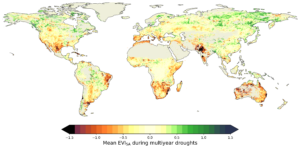Vegetation
 Challenge 2: Determine the impact on vegetation & groundwater
Challenge 2: Determine the impact on vegetation & groundwater
Challenge 2 explores the complex relationship between vegetation and drought, aiming to understand how prolonged dry conditions affect ecosystems on a global scale.
Drought-induced declines in vegetation, such as diminished plant growth, reduced crop yields, and increased tree mortality, are being reported worldwide. Droughts can trigger sudden, potentially irreversible shifts in ecosystem structure and function, with serious consequences for biodiversity, ecosystem services, and carbon storage.
Compared to “normal” droughts, multi-year droughts significantly increase vegetation mortality as local water resources become depleted. These extended droughts have a long-term impact on vegetation cover and disrupt the carbon and hydrological cycles. By closely linking vegetation to the hydrological cycle, we can quantify the critical role of water in vegetation’s resistance to drought. This approach also provides a benchmark for evaluating historical data and remote sensing observations of vegetation health.
The primary goal of Challenge 2 is to quantify the strength of vegetation-drought feedbacks during multi-year droughts, focusing on six key regions: California, central Argentina, South Africa, Western Europe, India, and Australia.
Finally, the storylines derived from Challenge 1 will be used to provide insight into the coupling between vegetation and drought and to identify which ecosystems are most vulnerable to the increasing frequency of multi-year droughts. As the intervals between droughts change, consecutive multi-year drought events may push ecosystems to the brink of collapse. Our study will address both trends and variability to fully capture the dynamics of multi-year drought impacts.

Figure: Map of the mean vegetation response to multi-year droughts (MYDs). Positive values (green) indicate the vegetation being greener than normal during MYDs, while negative values (red) indicate reduced greenness. Regions with sparse vegetation or with permanent snow and ice are masked.

